转发路由器TR(Transit Router)支持路由策略功能。路由策略支持过滤路由、修改路由属性,帮助您自定义云上网络互通能力。
工作原理
转发路由器是各个地域内路由表和路由策略的载体。路由策略通过关联至转发路由器的路由表对路由进行过滤,转发路由器分为基础版和企业版:
基础版转发路由器只包含一张默认路由表,路由策略创建后,自动关联至默认路由表。
企业版转发路由器除包含一张默认路由表外,支持创建自定义路由表。在添加路由策略时,您可以选择将路由策略关联至默认路由表或自定义路由表,路由策略只影响所关联路由表的路由传播。
关于转发路由器基础版和企业版说明及其功能介绍,请参见转发路由器工作原理。
路由策略支持在转发路由器的入地域网关(RegionIn)和出地域网关(RegionOut)两个方向分别配置路由策略,每条路由策略均是条件语句和执行语句的集合。路由策略按照优先级进行排列,优先级数字越小,优先级越高。执行路由策略时,路由从优先级最高的路由策略开始匹配条件语句,对于符合全部匹配条件的路由,路由策略将按照策略行为允许路由通过或拒绝路由通过,允许通过的路由支持修改路由的优先级、AS Path属性、Community属性;对于不符合全部匹配条件的路由,系统默认允许路由通过。
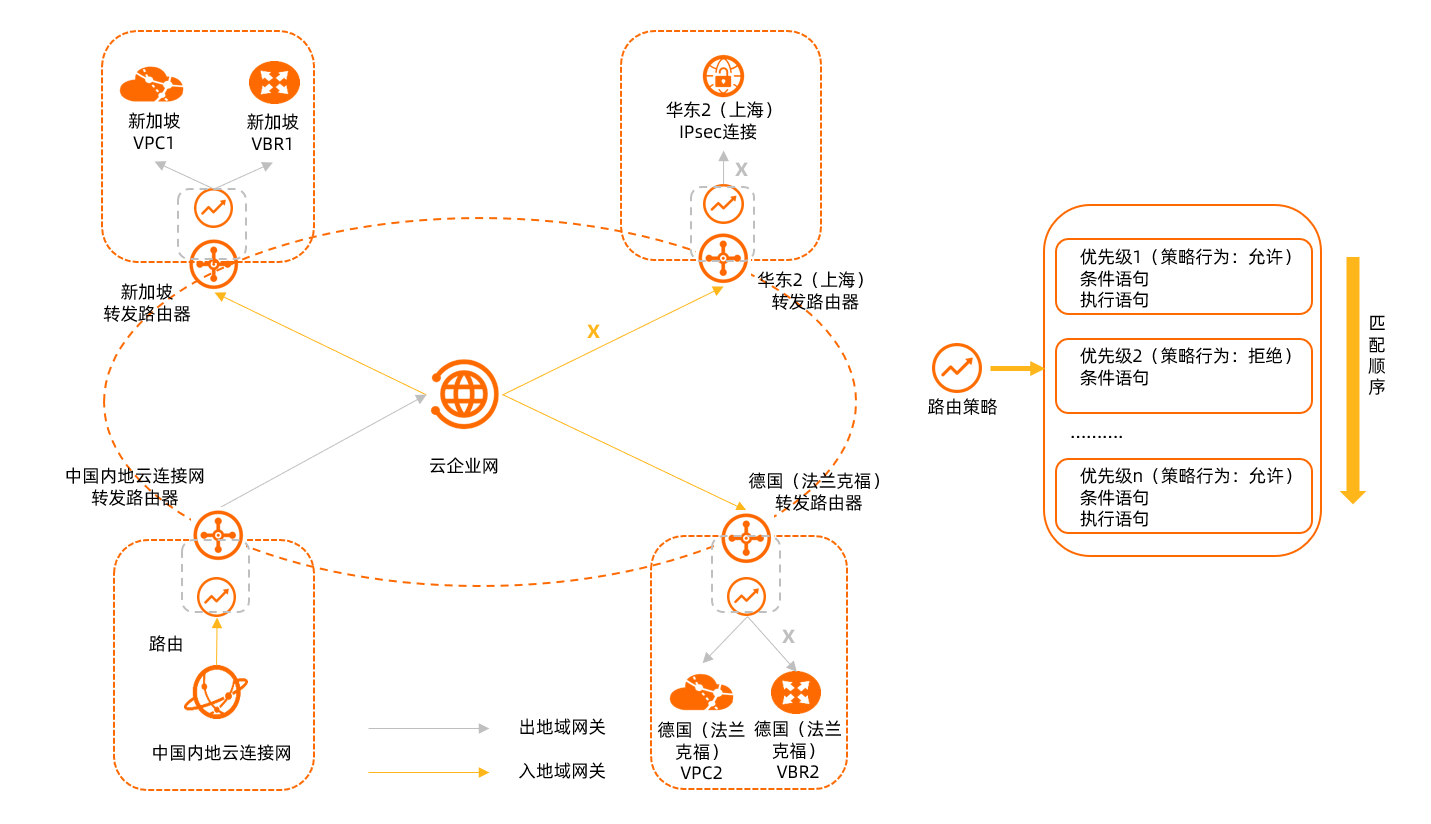
组成部分
路由策略包含策略基本信息、匹配条件和策略值三个组成部分,各个组成部分包含的元素信息如下表所示。
仅策略行为设置为允许时才支持设置策略值和关联策略优先级。
表 1.策略基本信息
元素 | 说明 |
策略优先级 | 路由策略的优先级。 取值范围:1~100。优先级数字越小,优先级越高。 同地域、同生效方向的路由策略优先级唯一。执行路由策略时,系统从优先级最高的路由策略开始匹配条件语句,因此在指定路由策略优先级时,要注意符合期望的匹配顺序。 |
描述 | 路由策略的描述信息。 |
地域 | 路由策略应用的地域。 说明 仅基础版转发路由器显示该项,路由策略创建完成后,将会对该地域基础版转发路由器路由表内的路由生效。 |
关联路由表 | 路由策略要关联的路由表ID。 说明 仅企业版转发路由器支持配置该项。路由策略仅对关联的企业版转发路由器路由表内的路由生效。 |
生效方向 | 路由策略应用的方向。
|
策略行为 | 所有条件都匹配通过后的策略行为。支持以下行为:
|
关联策略优先级 | 关联的下一条路由策略的优先级。
|
表 2.匹配条件
元素 | 说明 |
源地域 | 匹配所有产生于指定地域的路由。 |
目的地域 | 匹配所有发布到指定地域的路由。 说明 仅路由策略的生效方向为出地域网关方向,且目的地域ID非当前地域ID时,本选项才会生效。 |
源实例ID列表 | 匹配所有产生于指定网络实例ID的路由。支持输入以下类型的实例ID:
源实例ID列表支持排除匹配模式,即被匹配路由的源实例ID不在匹配条件中的源实例ID列表范围内表示匹配成功,否则匹配失败。 |
目的实例ID列表 | 匹配所有发布到指定网络实例ID的路由。支持输入以下类型的实例ID:
目的实例ID列表支持排除匹配模式,即被匹配路由的目的实例ID不在匹配条件中的目的实例ID列表范围内表示匹配成功,否则匹配失败。 说明 仅路由策略的生效方向为出地域网关方向,且目的实例ID为本地域下的实例ID时,目的实例ID列表才会生效。 |
目的路由表 | 匹配所有发布到指定路由表ID的路由。 说明 仅路由策略的生效方向为出地域网关方向,且目的路由表ID为本地域下网络实例的路由表ID时,目的路由表ID列表才会生效。 |
源实例类型 | 匹配所有产生于指定网络实例类型的路由。支持以下网络实例类型:
|
目的实例类型 | 匹配所有发布到指定网络实例类型的路由。支持以下网络实例类型:
|
IP地址类型 | 匹配指定IP地址类型的路由。支持以下IP地址类型:
如果不指定本匹配条件,则同时匹配IPv4路由和IPv6路由。 |
路由类型 | 匹配路由的路由类型。支持匹配以下路由类型:
|
路由前缀 | 匹配路由前缀。支持以下匹配模式:
|
AS Path | 匹配路由的AS Path。支持以下匹配模式:
说明 AS Path是公认强制属性,描述了一条BGP路由在传递过程中所经过的AS的号码。 |
Community | 匹配路由的Community。支持以下匹配模式:
说明 Community是可选传递属性,可以针对特定的路由设置特定的Community属性值,下游路由器在执行路由策略时,可以通过Community属性值来匹配目标路由。 |
表 3.策略值
元素 | 说明 |
路由优先级 | 设置允许通过的路由的优先级。 取值范围为1~100,路由默认优先级50,取值越小优先级越高。 |
Community | 设置路由的Community属性值。支持以下设置模式:
|
追加AS Path | 转发路由器接收或发布路由时为路由追加的AS Path。 路由策略生效方向不同,配置追加AS Path的要求也不同,具体如下:
|
匹配流程
路由策略采用match-action模式,即先匹配条件后执行动作。执行路由策略时,从优先级最高的路由策略开始匹配条件语句。
如果被匹配的路由满足路由策略中的所有匹配条件,则判断策略行为。
策略行为是允许:执行该路由策略中的执行语句并允许通过被匹配的路由。被匹配的路由默认不会再继续匹配下一条路由策略,但如果配置了关联优先级,被匹配的路由则需要继续匹配关联优先级的路由策略,如果未配置关联优先级,则匹配过程直接结束。
策略行为是拒绝:拒绝通过被匹配的路由,被匹配的路由默认不会再继续匹配下一条路由策略,匹配过程立即结束。
如果被匹配的路由与路由策略中任意一个匹配条件不匹配,则当前路由策略匹配过程直接结束,被匹配的路由继续匹配下一条路由策略。
如果被匹配的路由满足下一条路由策略中的所有匹配条件,则判断策略行为。
策略行为是允许:执行该路由策略中的执行语句并允许通过被匹配的路由。被匹配的路由默认不会再继续匹配下一条路由策略,但如果配置了关联优先级,被匹配的路由则需要继续匹配关联优先级的路由策略,如果未配置关联优先级,则匹配过程直接结束。
策略行为是拒绝:拒绝通过被匹配的路由,被匹配的路由默认不会再继续匹配下一条路由策略,匹配过程立即结束。
如果被匹配的路由与下一条路由策略中任意一个匹配条件不匹配,则当前路由策略匹配过程直接结束,被匹配的路由继续匹配再下一条路由策略。以此类推。
如果被匹配的路由匹配至最后一条路由策略,仍与该路由策略中的其中一个匹配条件不匹配,则允许通过被匹配的路由。
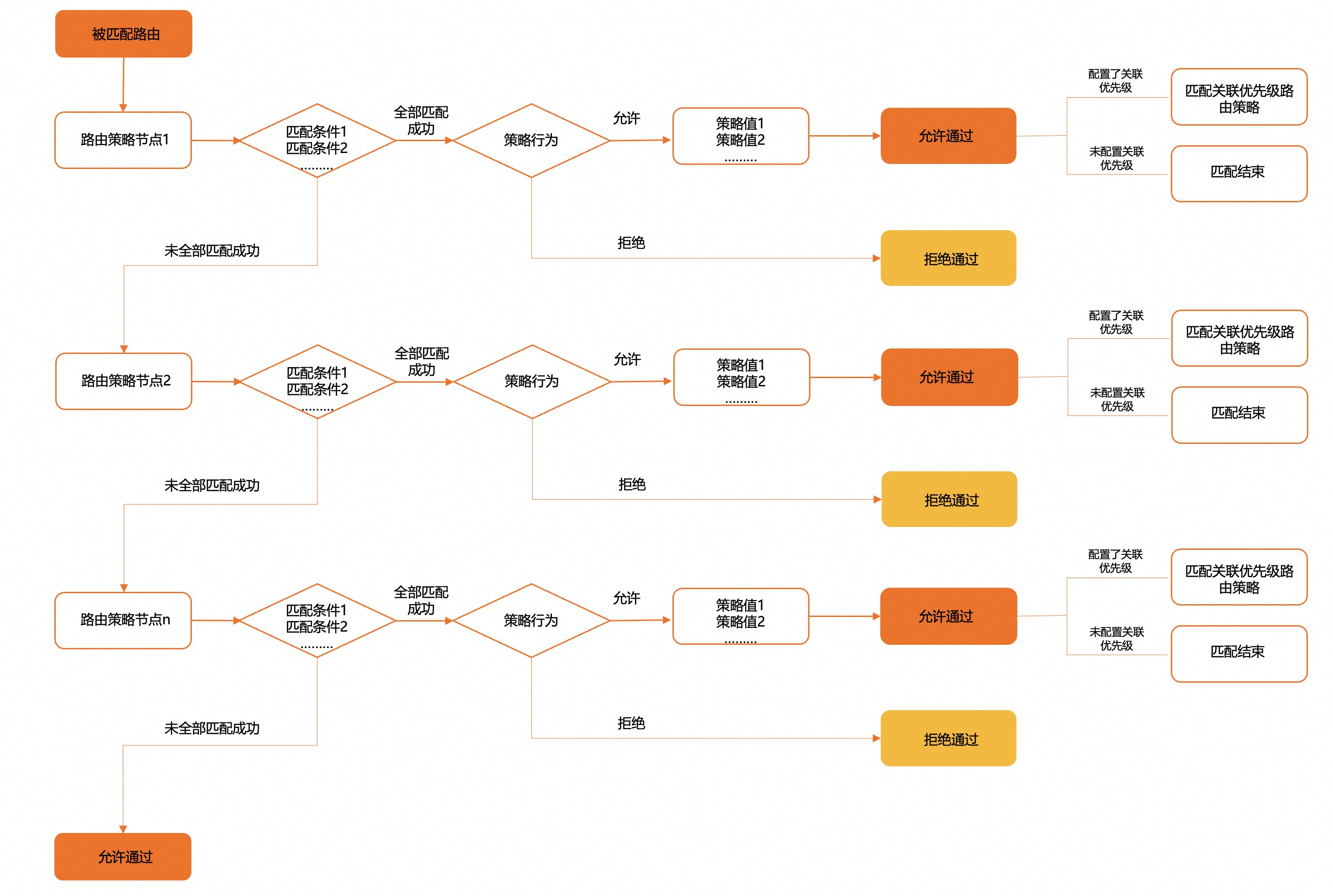
默认路由策略
系统默认会在转发路由器路由表的出地域网关方向添加策略优先级为5000、策略行为为拒绝的路由策略,该条路由策略会限制ECR、IPsec连接、VBR、CCN与转发路由器下的其它ECR、IPsec、VBR、CCN连接间的互通能力。转发路由器下VPC、ECR、IPsec连接、VBR、CCN之间的默认互通能力如下:
VPC与转发路由器下的其它VPC、ECR、IPsec连接、VBR、CCN互通。
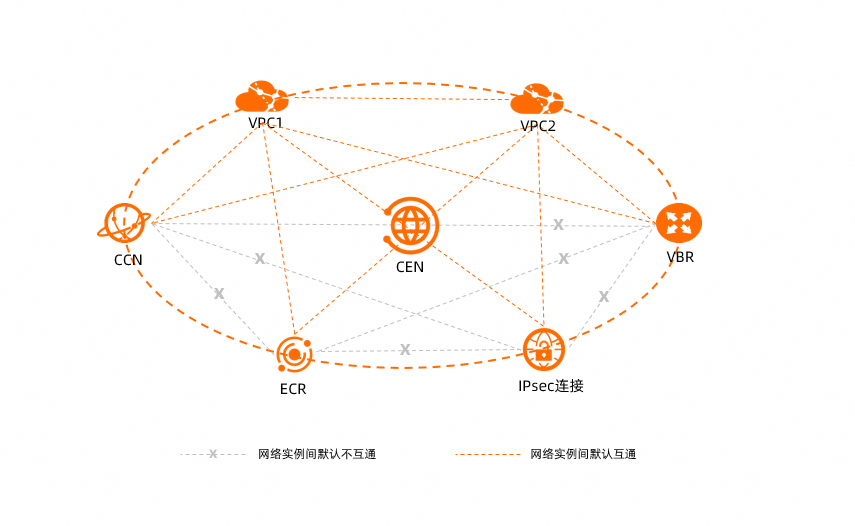
ECR与转发路由器下的其它ECR、IPsec连接、VBR、CCN不互通。
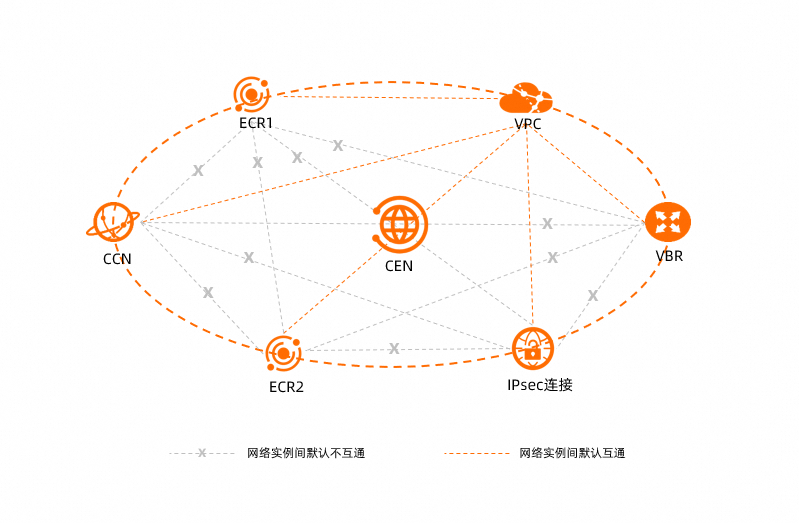
IPsec连接与转发路由器下的其它ECR、IPsec连接、VBR、CCN不互通。
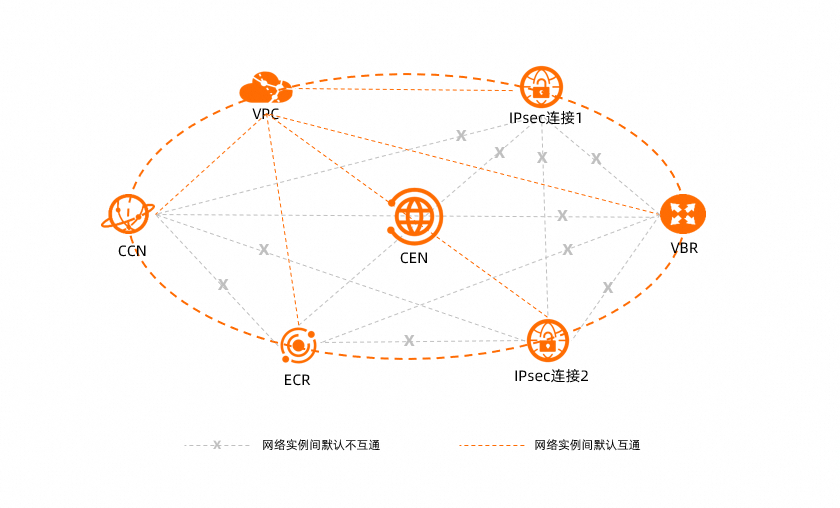
VBR与转发路由器下的其它ECR、IPsec连接、VBR、CCN不互通。
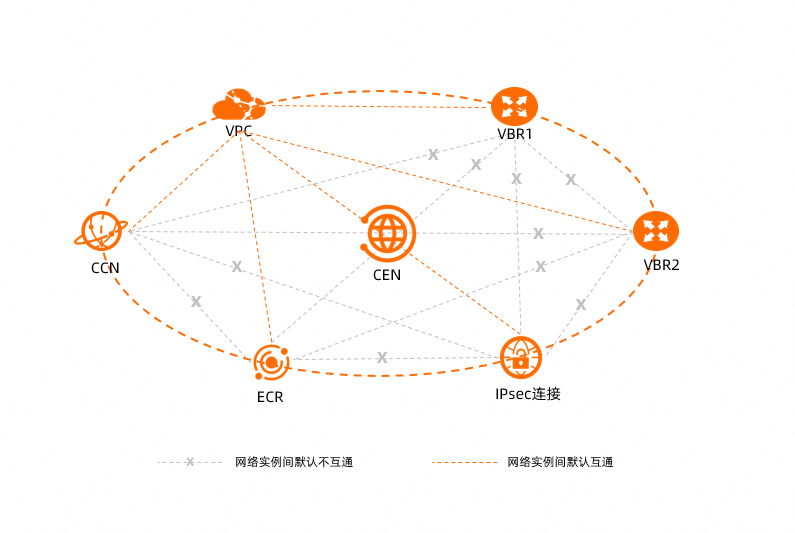
CCN与转发路由器下的其它ECR、IPsec连接、VBR、CCN不互通。
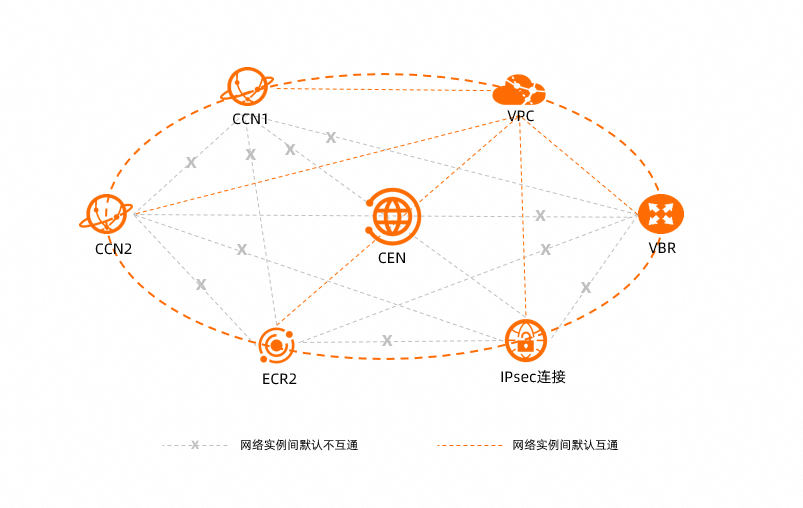
使用限制
资源 | 默认限制 | 提升配额 |
每个转发路由器支持创建的入地域网关方向的路由策略数量 | 100条 | 无法调整 |
每个转发路由器支持创建的出地域网关方向的路由策略数量 | 100条 | 无法调整 |
使用教程
通过路由策略功能,您可以灵活地定义云上网络互通能力,以下教程供您参考。